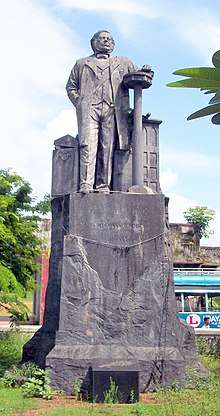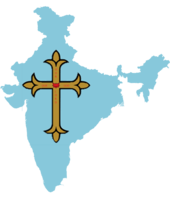Hermann Gundert
Rev. Dr. Hermann Gundert (Stuttgart, 4 February 1814 – 25 April 1893 in Calw, Germany) was a German missionary, scholar, and linguist, as well as the grandfather of German novelist and Nobel laureate Hermann Hesse. Gundert compiled a Malayalam grammar book, Malayalabhaasha Vyakaranam (1859), in which he developed and constricted the grammar spoken by the Keralites, nowadays; a Malayalam-English dictionary (1872), and contributed to work on Bible translations into Malayalam. He worked primarily at Thalassery on the Malabar coast, in Kerala, India. Gundert also contributed to the fields of history, geography and astronomy.[1]

Early years
At the age of five he entered Latin school in Stuttgart, joined the "Lower Seminary" at Maulbronn in 1827 and entered the "higher seminary" – the Protestant Stift – at the University of Tübingen. In 1835 he obtained a doctoral degree in philology from Tübingen and successfully completed his theological studies.
Journey to India and marriage
Having been engaged as private tutor in Calcutta (Kolkata), India, he prepared for this job in England. In April 1836 he left Bristol with the party of his employer. While traveling on the ship he concentrated on learning Bengali, Hindustani and Telugu and taught these languages to his fellow passengers. Instead of Calcutta the party reached Madras (Chennai) in July 1836 and settled there. Gundert immediately started learning Tamil. Soon he was giving a duty in Tirunelveli, and after some time in Chittoor (in nowadays Andhra Pradesh). There he married Julie Dubois in July 1838. She originated from French-speaking Switzerland and had come to India in the same party. After marriage, the two left for Tirunelveli, and on the way they were invited to join the Basel Mission in Mangalore. They accepted, and en route Gundert left Tamil drawing ups with a printer in Nagercoil. In Trivandrum (Thiruvananthapuram) Hermann Gundert had an audience with His Highness Sree Swathi Thirunal Maharaja, the ruler of Travancore. Most probably it was here he heard Malayalam for the first time.
In Kerala
In November 1838 Gundert and his wife reached Mangalore. From there he visited Cannanore (Kannur), Tellicherry (Thalassery) and the cinnamon plantation near Anjarakandy. A bungalow on Illikkunnu near Tellicherry was offered to the Basel Mission on condition that a mission station will be established over there. The Gunderts moved there and took up work in April 1839. In August 1839, Gundert stated that he had studied Malayalam intensively and that he had established the first Malayalam school in the veranda of the bungalow in May. At the same time his wife started the first girls' institute with boarding. In the following months, Gundert opened Malayalam schools in Kadirur, Thalassery Fort, Mahe, and Dharmadam. Regularly he visited all these schools and invited the teachers to Illikkunnu for further education. At times Gundert had five Pandits in his house, discussing old Indian history, philosophy and religion and studying the classical Indian literature. At his numerous visits to the villages around Tellicherry, Gundert got in close contact with the people, collected as many words, phrases and proverbs as possible and spread the Gospel. During this period, he published around thirteen books in Malayalam. Many of the material – old Malayalam documents and scriptures from Tellicherry and other places in Malabar – which Gundert had collected he later gave to University of Tübingen.
In the beginning of 1857, the government appointed Gundert as the first Inspector of Schools in Malabar and Canara – from Calicut (Kozhikode) in the South till Hubli in the North. He appointed teachers, wrote textbooks for schools, colleges and the newly established Madras University and also compiled examination papers. In Kerala, Gundert is venerated for his deep interest in the local culture as well as the development of Malayalam language, for compiling grammatical books for school starters as well as for University level. These grammars were the prominent non-Sanskrit-based approaches to real Indian grammar. Gundert is held in high regard to this day among linguistic experts in Kerala for the high scholastic aptitude exhibited in his work.
Scholarly work
During his stay in Illikunnu near Tellicherry (Thalassery), he published around thirteen books in Malayalam including a translation of the Bible, Old Testament from Hebrew and New Testament from Greek.[2] The archives of information he collected from Tellicherry are kept in the University of Tübingen and were collected and compiled by the scholar Dr. Scaria Zacharia as Thalassery Rekhakal.[3]
In Kerala, he took a deep interest in the local culture and the Malayalam language, attempting a systematic grammar of the language. This was one of the prominent non-Sanskrit-based approaches to Indic grammar. Gundert considered Malayalam to have diverged from Proto-Tamil–Malayalam, or Proto-Dravidian. Apart from the early inscriptions found on copper and stone, Gundert traced Malayalam to the Rāma Charitam, a poem predating the Sanskrit alphabet.[4]
Gundert is highly regarded among linguistic experts and his dictionary has been described as "monumental" in a review of the work on Dravidian languages.[5]
Publications
| Year published | Title | Description |
|---|---|---|
| 1843 | Keralolpathi | Origin of Kerala, translation from Malayalam Keralolpathi. |
| 1845 | Pazhancholmala | String of Malayalam proverbs for Christian theological idioms.[6] |
| 1851 | Malayala Bhasha Viyakaranam | Malayalam Grammar |
| 1860 | Paathamala | First textbook in Malayalam |
| 1868 | Kerala pazhama | 33 years of Keralite history, from Vasco da Gama's arrival in 1498 |
| 1871 | Malayalam-English Dictionary | |
| 1879 | Malayalarajyam | The land of Malayalam |
| 1847 June | Rajyasamacharam (News of the Kingdom) | Newspaper[7] |
| 1847 October | Paschimodayam | "Rise of the West" or "Dawn of the West", a magazine |
Other contributions
- He was the one who introduced the punctuation marks – full stop, comma, semicolon, colon, and question mark – into the Malayalam language.
- Malayalam-English Dictionary. He returned to Germany in 1859. There he took ten more years to complete the dictionary. (1872)[2] A number of words in this dictionary are not in use these days. But this is a priceless treasure for those who study the development of Malayalam.
Years in Germany

Due to poor health Gundert had to leave India in 1859. In Calw, the Black Forest, he joined the Calw Publishing House and became its director in 1862. He published many books and articles as well as several magazines, including a children’s magazine. Julie Gundert died in Calw on 18 September 1885, and Hermann Gundert on 25 April 1893. Both were buried on the Calw cemetery, where the family grave still exists.[2]
Though Gundert came to Kerala as a missionary, he is remembered today mainly for his literary contributions. In the city of Thalassery (Tellicherry), he has been honored with a statue. The bungalow in which he used to live is now the home of the Nettur Technical Training Foundation (NTTF).
References
- "Achatiyum Aadyakaala Pathramaasikakalum" (Printing, Early Newspapers and Magazines). Madhyamangalum Malayalasahithyavum (Media and Malayalam Literature) Kunhukrishnan, K. Sivasankaran, M.K et al. Thiruvananthapuram: State Institute of Languages, 2000.
- Malayalam-English Dictionary, by Dr. Herman Gundert, 1872. Ed. 3, Published by Sahythia Pravarthaka Sahakarana Sangham, Kerala, 2000. Biography. Pages 7-11
- Skaria Zakharia, ed. Thalassery Rekhakal. Kottayam: DC Books.CS1 maint: extra text: authors list (link)
- Gundert, Hermann (1872). A Malayalam and English Dictionary. Mangalore: C. Stolz for Basel Mission Book Tract Depository. p. 14.
- p. 18, Bhadriraju Krishnamurti. 2003. The Dravidian Languages. Cambridge University Press. ISBN 0-521-77111-0.
- Pazhancholmala by Hermann Gundert. Tübingen University Library. 1845. Retrieved 15 October 2018.
- "Herman Gundert - Kerala Press Academy". 14 May 2013. Archived from the original on 14 May 2013. Retrieved 5 April 2018.
Further reading
- Frenz, Albrecht (1979). "Hermann Gundert: A Biography". IX All India Conference of Dravidian Linguists. Calicut. pp. 9–15.
- Frenz, Albrecht (1993), "Gundert as a Man", in K. K. N. Kurup; K. J. John (eds.), Legacy of Basel Mission and Hermann Gundert in Malabar, Calicut, pp. 9–32
- Frenz, Albrecht and Scaria Zacharia (1993). Dr. Hermann Gundert and Malayalam Language. Kottayam: Centre for Kerala Studies.
- Jenkins, Paul (1998), "Gundert, Hermann", in Gerald Anderson (ed.), Biographical Dictionary of Christian Missions, New York: Simon & Schuster Macmillan, pp. 270–271
- Malayalam-English Dictionary, by Dr. Herman Gundert, 1872. Ed. 3, Published by Sahythia Pravarthaka Sahakarana Sangham, Kerala, 2000. Biography.
